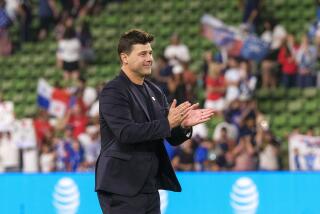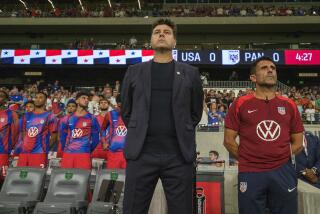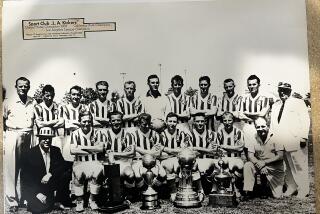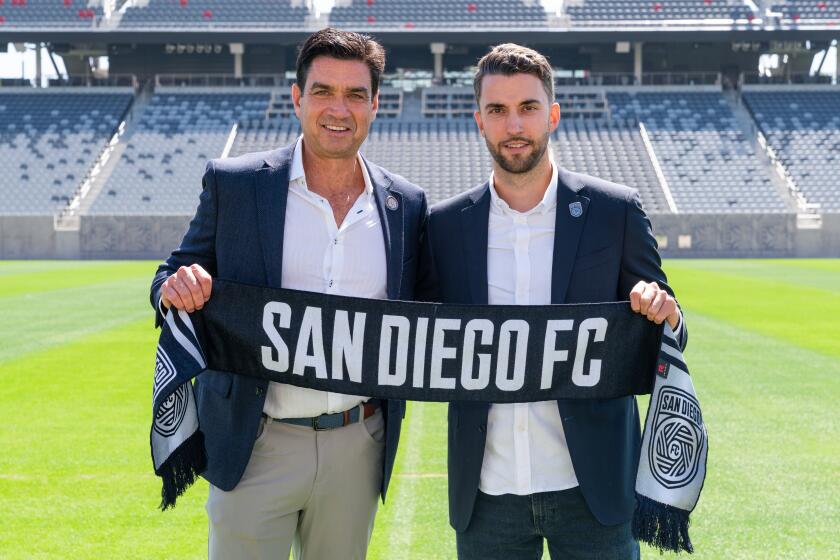Commentary : U.S. Soccer: Where Does the World Cup Team Go From Here?
FLORENCE, Italy — Most of the 22 players who represented the United States in its first World Cup soccer appearance in 40 years returned home today. They left with a wealth of experience and experiences, but also with three losses in three games.
The post-mortem:
Question: Was the team’s performance better or worse than expected?
Answer: Both. Although the United States did not play as well as it expected, it was better than the rest of the world thought when the tournament began.
Despite the odds against it established by London bookmakers, the United States was not the worst of the 24 teams. That distinction belonged to the United Arab Emirates. The United States also scored two goals, which is two more than most people predicted.
Q: Was Bob Gansler the right man to coach the team?
A: If the United States actually expected to realize its goal of advancing to the second round, the answer is no.
Having never attended a World Cup game, not even as a spectator, Gansler did not have his team psychologically prepared for the opening game against Czechoslovakia.
He watched the Czechs play numerous games on film and once in person. He was unimpressed, believing that his team could finish that game with a tie or maybe even a victory.
But he was surprised that the Czechs were able to raise their intensity level to such a high degree for the World Cup. As a result, so were his overconfident players. They were overwhelmed in a 5-1 loss.
Q: Should Gansler be retained as the coach for the 1994 World Cup in the United States?
A: Definitely. Now that he has a World Cup behind him, the United States should not waste his experience. He is a thoughtful, intelligent coach who learns from his mistakes.
In the second game he proved to the world that he can coach. His strategy and his players’ ability to implement it contained Italy to a 1-0 victory.
Q: Who were the most impressive players?
A: Midfielder Tab Ramos of Hillside, N.J., and defender John Doyle of Fremont, Calif.
The team’s most skilled player, Ramos might emerge with a contract in the Dutch first division. At only 5 feet, 7 inches and 140 pounds, he can be knocked off the ball too easily to continue in his role as a play maker. But he might be effective as an active forward.
On the other end of the scale at 6-3 and 185, Doyle proved he could hold his own with the strongest forwards. Italy’s Andrea Carnevale and Austria’s Toni Polster were benched during games against the United States because they were ineffective against Doyle.
Q: Will the team still be together for the 1994 World Cup?
A: If you are a U.S. soccer fan, you can only hope the answer is no. As the youngest team in the tournament with an average age of 24.2 years, the United States has some players who will just be reaching their prime in four years. But the United States must have players who are better athletically and technically if it intends to advance beyond the first round. That was the most important lesson learned from this World Cup.
Q: How can it find those players?
A: It has some on this team who might be able to raise their games to the necessary level.
Three reserves, midfielders Chris Henderson and Neil Covone and goalkeeper Kasey Keller, are young enough to play on the under-23 team, which will begin its attempt later this year to qualify for the 1992 Summer Olympics. That will give them additional international experience.
Other players may have opportunities to play in European professional leagues. Unfortunately, players who do not have those opportunities have little chance to improve.
For college players who are not members of national teams, their seasons are too short.
For older players, there is no professional outdoor soccer league in the United States that enables them to make a living. The American Professional Soccer League has a salary cap of $75,000 per team, which means no player earns more than about $10,000.
One solution would be a legitimate professional league, but the U.S. Soccer Federation still does not have a plan, two years after it announced that it would develop one.
At least through the end of this year, the federation plans to maintain a national team that will play an extensive schedule, beginning July 28 in Milwaukee against East Germany. But Gansler calls that concept over a four-year period “a traveling Gypsy band that will drive the players and me insane.”
Most important, however, the federation must reach out to more players. Most of its talent pool consists of white, middle-class suburban products of the American Youth Soccer Assn. It will not succeed until the Michael Jordans and Bo Jacksons are playing soccer.







